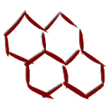A collaboration work between our group and Michael Strano’s group at MIT has been recently accepted to Nature Chemistry! Preprint is available at arXiv:1207.3369.
Chemical reactivity imprint lithography on graphene: Controlling the substrate influence on electron transfer reactions
Qing Hua Wang, Zhong Jin, Ki Kang Kim, Andrew J. Hilmer, Geraldine L.C. Paulus, Chih-Jen Shih, Moon-Ho Ham, Javier D. Sanchez-Yamagishi, Kenji Watanabe, Takashi Taniguchi, Jing Kong, Pablo Jarillo-Herrero, Michael S. Strano
The chemical functionalization of graphene enables control over electronic properties and sensor recognition sites. However, its study is confounded by an unusually strong influence of the underlying substrate. In this paper, we show a stark difference in the rate of electron transfer chemistry with aryl diazonium salts on monolayer graphene supported on a broad range of substrates. Reactions proceed rapidly when graphene is on SiO_2 and Al_2O_3 (sapphire), but negligibly on alkyl-terminated and hexagonal boron nitride (hBN) surfaces. The effect is contrary to expectations based on doping levels and can instead be described using a reactivity model accounting for substrate-induced electron-hole puddles in graphene. Raman spectroscopic mapping is used to characterize the effect of the substrates on graphene. Reactivity imprint lithography (RIL) is demonstrated as a technique for spatially patterning chemical groups on graphene by patterning the underlying substrate, and is applied to the covalent tethering of proteins on graphene.

